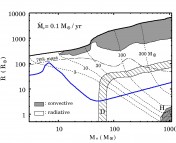When Dilhan Ezer Eryurt (1926 – 2012) arrived at NASA Goddard Space Flight Center in 1961, she became the first Turkish astronomer to work at NASA and the only woman at the center. In a decade filled with the scientific and technical build-up to putting men on the moon, Eryurt was hardly the only woman whose story was drowned out. Even today, it is difficult to find more than a biographical sketch about the woman whose contributions to heliophysics were monumental and who garnered a status as an international astronomy ambassador.
In her seven years at Goddard, Eryurt changed the understanding of pre-main sequence stellar evolution. A particularly powerful paper of hers was published in 1963 and is summarized below as part of today’s Beyond post. By providing more accurate models of the early Sun, Eryurt helped NASA scientists predict the conditions of the lunar surface more accurately, earning her the prestigious Apollo Achievement Award in 1969.

Eryurt’s contributions to science hardly ended when she left Goddard. Upon returning to Turkey, she was a leading voice in convincing the Turkish government to establish a national observatory. She organized the first National Astronomy Congress in 1968. She founded the Astrophysics division at Middle East Technical University in 1973, later becoming Chair of the Physics Department and Dean of the Faculty. In time, she gained the reputation “mother of Astronomy in Turkey.”
On July 20, she was celebrated with a Google Doodle on the 51st anniversary of the Apollo 11 moon landing.
Title: The Early Evolution of the Sun
Authors: Dilhan Ezer [Eryurt] and A. G. W. Cameron
First Author’s Institution: Goddard Institute for Space Studies, NASA
Status: Published in Icarus (1963), closed access
One of the first coherent theories on how gravitationally contracting protostars evolve was proposed in a 1955 paper by Louis Henyey. The simplified model assumed that the protostar is in radiative equilibrium as it collapses, meaning that the gravitational potential energy liberated by contraction is all converted into heat and light. As contraction continues (shown in Figure 1), the Henyey model found that the protostar would increase luminosity until the core becomes dense enough to ignite nuclear fusion. At that point the star joins the main sequence.

In 1961, Chushiro Hayashi published two papers calling into question the Henyey result, because a star in pure radiative equilibrium is not fully stable and would create convection. What Henyey didn’t account for, is how heat is trapped by the outer envelope of a star, causing the temperature gradient to get steeper and steeper. At a certain point, the outer layer becomes too unstable and the hot inner regions literally bubble up from below, causing turbulence. The result is a convective layer.
Once a protostar has a convective layer, its luminosity, temperature, and evolution become different than Henyey’s theory predicts. Though Hayashi’s theory was well-received, it still had not been modeled sufficiently for the Sun. This is where Eryurt comes in.
Testing the Theory
In this paper, Eryurt created a model of protostar gravitational contraction. In fact, it isn’t the first time she had built a star model. Her model starts with three equations of stellar structure for mass, pressure, and luminosity. The fourth structure equation, for temperature, depends on whether radiative equilibrium or convective equilibrium applies. The model works with radiative equilibrium and looks for where it is broken, there applying convective equilibrium. Adding in the possibility for deep convection throughout the star was a major improvement over other models.
Another significant improvement as the handling of boundary conditions. The entire calculation of stellar interior can change based on what is assumed at the photosphere (stellar atmosphere). To reproduce conditions in the photosphere, Eryurt’s model considered many types of particle interactions, as well as radiation absorption, and ionization. Collectively these factors determine solar opacity and improve the reliability of the overall model findings.
A New Understanding of the Sun
Eryurt ran 27 models representing different possible starting conditions for the proto-Sun. Each of these starting conditions is essentially a snapshot in time of an evolving young Sun, so they can be plotted on the Herzsprung-Russell (H-R) diagram and connected to form a path. Figure 2 shows the temperature and luminosity of the Sun as it contracted.

The significance of Figure 2 should not be understated: this was the first stellar model that showed that protostars (including the Sun) are significantly more luminous during contraction than when on the main sequence. As they contract, they decrease in luminosity dramatically and only slightly increase in temperature.
This path downward in the H-R diagram is today referred to as the Hayashi track, but it might as well have been named for Eryurt, whose work demonstrated it.
Notice on Figure 2 the few points toward the bottom of the track that turn off the vertical path and move left toward higher temperature. Eryurt was quick to admit that the last two points are likely unphysical but the first two represent something meaningful. At the end of the Hayashi track, a protostar isn’t quite ready to begin hydrogen fusion and join the main sequence. It has to get hotter first.
It turns out that Henyey wasn’t completely wrong when he proposed that protostars increase in luminosity as they form; that is, the last portion of the Figure 2 track aligns with the tracks in Figure 1. Today we call that the Henyey track, but again, Eryurt was the one whose accurate stellar model rescued the misguided predictions put forth by Henyey.
Though her major discoveries do not bear her name, Dilhan Eryurt made contributions to stellar astrophysics that are prominent in textbooks and the backbone of much of today’s work on star formation. Hopefully, we will evolve to better appreciate her contributions toward astronomy (and the contributions of many other women) in addition to her life’s work as an ambassador for science.




